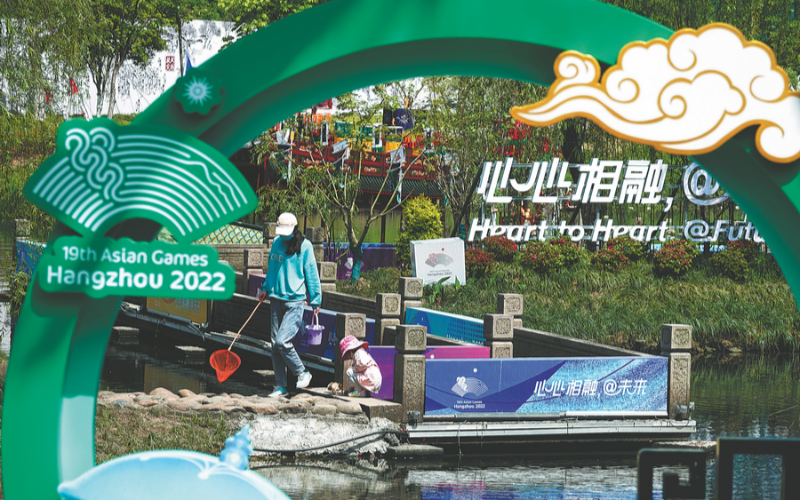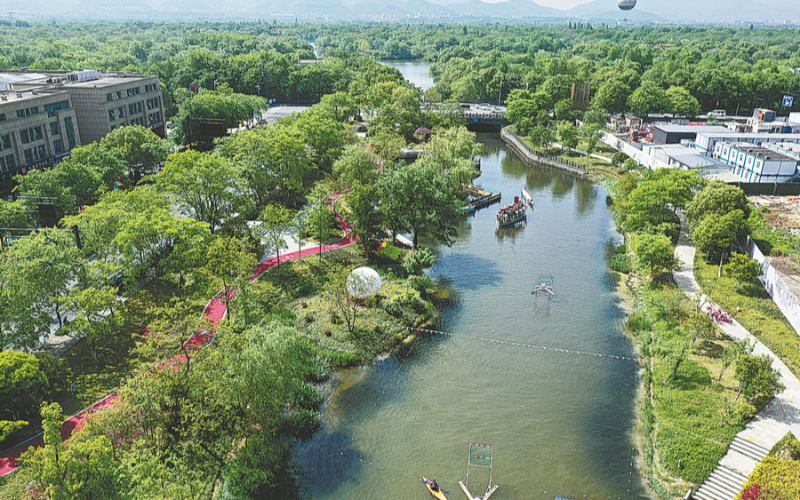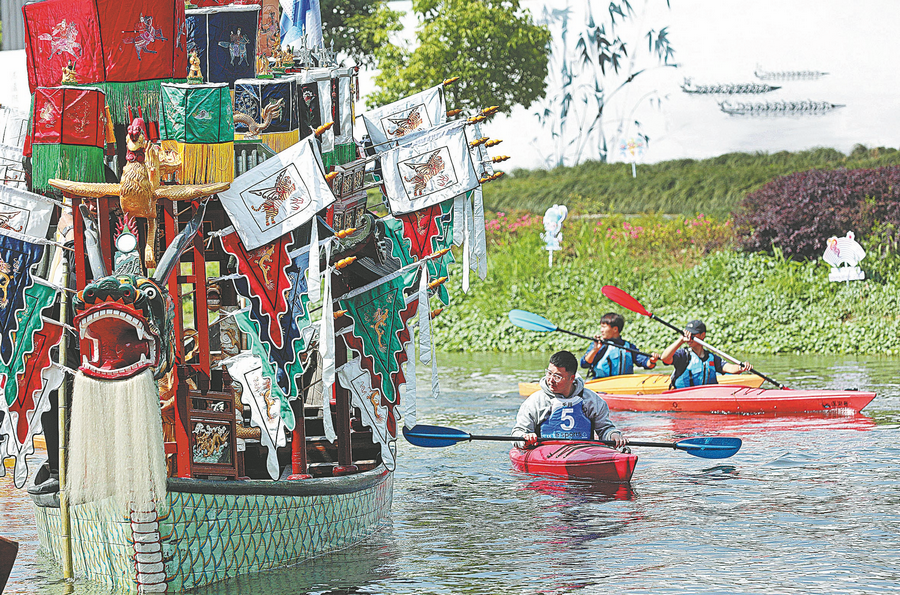Diverse delights of Asian Games host city

Jiangcun Port Asian Games Theme Park in Xihu district, Hangzhou is open to the public on April 21. [Photo by Li Zhong/For China Daily]
Day 1 Travel with Asian Games' mascots
Since their debut for the 19th Asian Games in Hangzhou in September, the three mascots, animated characters Congcong, Lianlian, and Chenchen, have become increasingly popular.
They can be seen in numerous settings, including countdown devices, landscape sculptures, light boxes, buses and metros as the Games approach.
The mascots' designs were inspired by Hangzhou's World Heritage sites, which are surrounded by many scenic spots.
The first mascot Lianlian, represents and is named after the lotus flower blooming in the West Lake.
The West Lake Cultural Landscape of Hangzhou, which comprises the West Lake and the hills on its three sides, was inscribed on UNESCO's World Heritage List in June 2011.
The landscape not only continues to inspire poets, scholars and artists, as it has since the ninth century, but it also serves as a model for seeking a harmonious balance between urban development and heritage preservation.
As one of the most famous tourist attractions in Hangzhou, West Lake offers visitors different highlights depending on the season, which are also known as the Ten Scenes of West Lake. These include: Su Causeway; Breeze-Ruffled Lotuses at Quyuan Garden; Lingering Snow on Broken Bridge; Leifeng Pagoda at Dusk and Three Pools Mirror the Moon, which, as the name suggests, should be visited at sunset or on moonlit nights.

The Hangzhou Asian Games Park is designed for multi-sports competition during the upcoming Asian Games. [Photo by Long Wei and Li Zhong/For China Daily]
Some places can be visited at any time regardless of seasonal or weather conditions, including Orioles Singing in the Willows, Twin Peaks Piercing the Clouds, and Evening Bell Ringing on Nanping Hill.
The second mascot Congcong is named after the jade Cong, a representative cultural relic unearthed from the Archaeological Ruins of Liangzhu Culture.
The Archaeological Ruins of Liangzhu City, which date back 5,300 years, are considered an important representation of early urban civilization, with rice-cultivating agriculture as the economic foundation.
The site is also known for its abundance of ceremonial jade, which reveals a complicated ritual system and indicates a realm with a combined authority of deity and kingship.
In Liangzhu Ancient City Ruins Park, it is recommended to take a sightseeing bus for just over three hours, where you can enjoy many scenic spots, including the city gate and ancient wall, the Zhishan viewing platform, Mojiaoshan Palace, Fanshan Cemetery, West City Wall Ruins, Fengshan Research Base, Daguan Mountain Rest Area, Deer Garden and many other sites.
The Children's Archaeological Area in the park is popular as the younger ones can dig sand, paint, solve puzzles, restore ancient artifacts and pretend to be archaeologists discovering precious cultural relics.
The last one Chenchen, named after Gongchen Bridge with a history of more than 400 years, is a famous cultural landmark spanning the thousand-year-old Grand Canal.
The Beijing-Hangzhou Grand Canal, operating for more than 2,500 years, is the oldest and longest artificial waterway in the world. Known as one of the two magnificent projects of ancient China, the canal is as famous as the Great Wall in Beijing.
The Hangzhou section of the canal stretches a total length of 39 kilometers. It enters the city from Tangqi ancient town in Yuhang district, travels through Gongshu and Shangcheng districts, and finally flows into the Qiantang River from the Three Gorges Ship Lock.
Visitors are recommended to take a boat trip on the ancient waterway to enjoy some of its unrivaled scenery as well as the fascinating landscape of Jiangnan Water Town.
Besides the activities on the water, three neighboring places along the Canal-Dadou Road Historic District, Xiaohezhi Street, and Qiaoxi Historic Street are recommended for a leisurely walk.
The Gongshu Canal Sports Park Gymnasium, also called Hangzhou Umbrella due to its shape, is a large-scale comprehensive urban park integrating leisure green space, sports venues and commercial blocks in the main urban area of Hangzhou.
The park was constructed with the priority of protecting its surrounding rivers and trees to serve the Games as well as the public. It is warmly welcomed and greatly appreciated by parents and their children and those who love exercise.

A dragon boat has become a tourist attraction in Jiangcun Port Asian Games Theme Park. [Photo by Lin Yunlong/For China Daily]
Day 2 Parent-child travel route recommended in Qiantang district
As many efforts have been made to sort out public cultural resources and bring back to life dormant areas, various visiting sites are proving popular for students and children to boost their awareness and carry forward an appreciation of cultural heritage.
For example, visitors can visit Wensli Xiasha Silk Industrial Park, Zhuoshang Clothing and Wahaha Industrial Park in Qiantang district for a day. Visitors can learn weaving techniques in the Silk Museum and experience activities such as picking mulberry leaves, and tying silk scarves here.
If you are interested in reading, Qiantang Study, close to the above-mentioned places, is a good choice and was rewarded as one of the 2021 Top 10 Most Beautiful Studies in Hangzhou.
It consists of a public lending area, children's activity space, exhibition hall and a cultural and creative display and sales space.
At present, there are more than 10,000 books in its collection, and visitors can avail of borrowing with ID cards, citizen cards, Alipay, etc. It also provides digital reading and audition experiences and also holds various cultural-themed activities.
Qiantang district will host several Asian Games competitions such as fencing, handball, roller skating and skateboarding, as well as some Asian Paralympic Games events, with a total of 72 gold medals to be rewarded here.
The skate park, especially, is well-received by young citizens. It consists of two major competition venues: street skateboarding and bowl skating.
Fang Xiaoying in Hangzhou contributed to this story.


